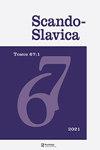The Texture of Type: Nabokov’s Sensory Perception of Alphabetical Letters: The Semanticized Graphic Form
IF 0.2
0 HUMANITIES, MULTIDISCIPLINARY
引用次数: 0
Abstract
ABSTRACT My paper investigates how Nabokov’s synesthetic perception of typographic letters as images was expanded into a special letter-coding semanticizing practice and discusses the important questions raised by this strategy with regard to the theory and practice of literary analysis. I argue that Nabokov reconceives and expands his biologically determined binary (letter-with-color) synesthetic associations in a cross- and self-referential system of motifs permeating the whole oeuvre. Consciously controlling his personal experience of his synesthetic mind, Nabokov extrapolates it by adding images and objects and how in this artistic method he attaches symbolic or emblematic notions to letters through color- and object-associations. This complex meaning of letters can be unfolded from supporting codes, metaphors and motifs that trigger adequate contextual interpretations. His prose invites the same meticulous text-decoding methodology demanded by Symbolist and avant-garde prose art that helps to discover a similar segment in the theory of art of these two literary tendencies reputed as antithetical. 1 1 The article was written in the framework of the project “The Border Zone Paradigm: Crossroads in Culture” (2018–2020) funded by the Russian Foundation for Fundamental Research (No. 18–512–23002).类型的纹理:纳博科夫对字母的感官知觉:语义化的图形形式
本文研究了纳博科夫将字体作为图像的联觉知觉如何扩展为一种特殊的字母编码语义化实践,并讨论了这一策略在文学分析理论和实践方面提出的重要问题。我认为,纳博科夫在贯穿整个作品的交叉和自我指涉的主题系统中,重新构思并扩展了他的生物学决定的二元(字母与颜色)联觉联系。纳博科夫有意识地控制他的联觉心灵的个人经验,通过添加图像和物体来推断它,以及如何在这种艺术方法中,他通过颜色和物体的联想将象征性或象征性的概念附加到字母上。字母的这种复杂含义可以从支持代码、隐喻和母题中展开,从而引发适当的上下文解释。他的散文采用了象征主义和先锋派散文艺术所要求的同样细致的文本解码方法,这有助于在艺术理论中发现这两种被认为是对立的文学倾向的相似部分。11本文是在俄罗斯基础研究基金会(18-512-23002)资助的“边境地区范式:文化的十字路口”项目(2018-2020)的框架内完成的。
本文章由计算机程序翻译,如有差异,请以英文原文为准。
求助全文
约1分钟内获得全文
求助全文

 求助内容:
求助内容: 应助结果提醒方式:
应助结果提醒方式:


